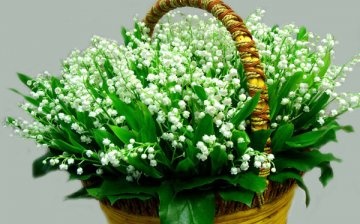Lily of the valley: care for a delicate spring flower
Lily of the valley, despite all its external refinement, fragility and sophistication, is a fairly resistant plant that, as a rule, is not afraid of either the effects of low temperatures or annoying weeds. Growing these tiny, cute flowers is easy enough: you just need to find the right place to plant, regularly water and fertilize the plants, and then in late spring your garden will be decorated with a green and white carpet, exuding a heady aroma.
Lily of the valley feels best in shaded areas, sheltered from direct sunlight, so these flowers are recommended to be planted in the shade of any other plants, for example, large branched trees or spreading shrubs such as elderberry, bird cherry, lilac. In this case, it is very important to plant plants in an area with suitable soil: it should contain a large amount of moss, deciduous humus, and also peat.
Lilies of the valley are more than moisture-loving plants, so they must be watered regularly and abundantly. It is especially necessary to ensure that the soil is constantly moist during the hot summer months: without sufficient watering, the leaves of the plants will turn yellow and dry very quickly. Among other things, one should not forget that the soil under these plants needs regular feeding. It is best to fertilize lilies of the valley with an aqueous solution of any mineral fertilizer of complex action, but ordinary rotted manure mixed with deciduous humus can also be used (such fertilizer must be applied to the top soil layer).




These wonderful flowers, exuding an incredibly sophisticated aroma, tend to grow very well over time under favorable conditions.
I remember as a child my grandfather brought lilies of the valley from the forest, specially to plant them in the country. Then my mother planted lilies of the valley in a flower bed in the yard under the balcony. There they have been growing for many years - no one cares for them, they do not feel bad anyway.
Once upon a time, a neighbor in the garden thinned out her lilies of the valley and gave me several rhizomes. I thought it would be troublesome, but it turned out that, despite all its beauty and tenderness, the lily of the valley is in no way inferior to weeds, which is why the neighbor thinned it periodically. But at the same time, it does not allow weeds to grow. Therefore, I planted it around the apple trees so that no nettles would grow under them, etc. It looks very nice.
It came as a surprise to me that the lily of the valley steadily tolerates low temperatures above zero. Looking at the delicate flowers and leaves, you will never think that such a creature can calmly tolerate zero temperature.